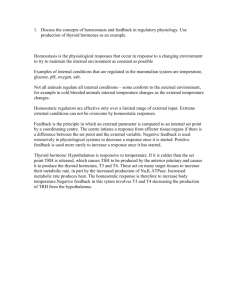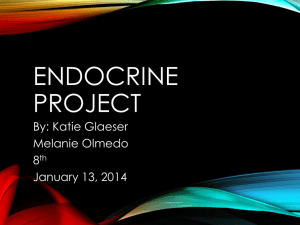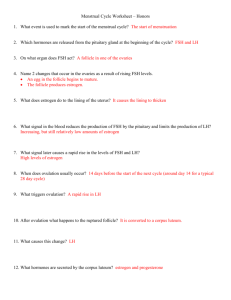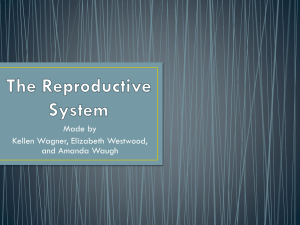Gonad Glands
advertisement
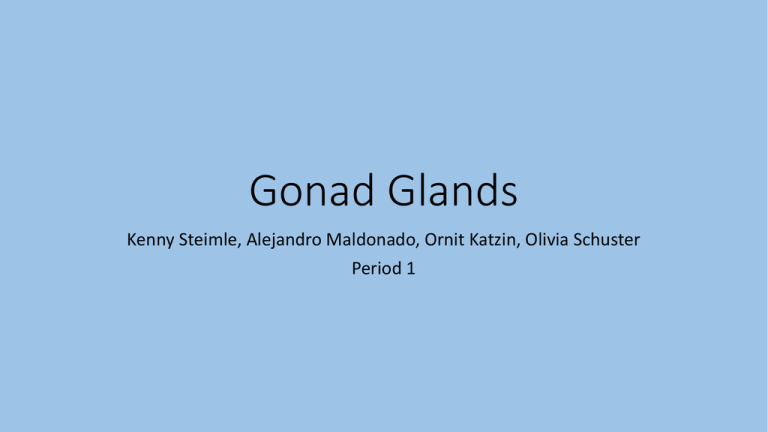
Gonad Glands Kenny Steimle, Alejandro Maldonado, Ornit Katzin, Olivia Schuster Period 1 Hormones • The 3 hormones associated with the gonad glands are: 1. Testosterone 2. Estrogen 3. Progesterone Testosterone • Testosterone is secreted in the testes and is necessary for proper physical development in boys. • Testosterone is involved in many of the processes in puberty. • • • • • • Healthy development of male sex organs Growth of facial and body hair Lowering of the voice Increase in height Increase in muscle mass Growth of the Adams apple • Through manhood it functions to maintain many processes. • • • • Maintains sexual desire Sperm production Maintain strength and mass Promoting healthy bone density Estrogen • Produced in ovaries and, in lesser amounts, by the adrenal cortex, placenta, and male testes. • Role/Function: • Not known what it does in males • Growth and development of sexual characteristics and the reproductive process • If fertilization does occur, estrogen and progesterone work together to prevent additional ovulation during pregnancy • Estrogen by working with calcium, vitamin D, and other hormones and minerals helps prevent bone loss. • However once estrogen levels start to decline, bone breaks down faster than it builds. • Therefore after menopause, women lose about 20 percent of their bone mass. Progesterone http://www.dailymotion.com/video/x1cxceu_what-isprogesterone-for-pregnantfirst-com_lifestyle • Progesterone is a hormone released by the corpus luteum in the ovary o The corpus luteum is what is left of the follicle after a woman ovulates. o After a woman ovulates if the egg is not fertilized, the corpus luteum dies and progesterone production stops. When progesterone levels drop, the uterus lining stops thickening and sheds during a woman’s menstrual cycle • Role/Function: plays an important part in the menstrual cycle and in maintaining the early stages of pregnancy o Helps prepare the uterus for pregnancy. o Progesterone causes the uterine lining to thicken and helps prepare a supportive environment in your uterus for a fertilized egg o During pregnancy the progesterone maintains a supportive environment Hypogonadism http://www.youtube.com/watch?v=GjXqqDWrHA0&edufilter=d 3ViuWqXvxQy1rRgssBz8Q&safe=active • Also known as “Gonad deficiency” • In males it may be called low serum testosterone or • Andropause • Occurs when your sex glands produce little or no sex hormones (testosterone) • Two types of hypogonadism • Primary hypogonadism: not enough sex hormones due to problem in the gonads. Gonads receive message to produce hormones but are unable to produce them • Central Hypogonadism: problem lies in the brain. Hypothalamus and pituitary gland (which control the gonads) are not working properly Primary Hypogonadism Causes • autoimmune disorders, such as Addison’s disease and hypoparathyroidism • genetic disorders, such as Turner syndrome and Klinefelter syndrome • infection • liver and kidney diseases • radiation exposure • surgery on the sex organs Central Hypogonadism Cause • genetic disorders, such as Kallmann syndrome • infections, including HIV and AIDS • pituitary disorders • obesity • rapid weight loss • nutritional deficiencies • use of steroids or opiates • Etc. Symptoms • Loss of body hair • Muscle loss • Breast growth • Reduced growth of penis and testicles • Erectile dysfunction • Low sex drive • Etc. Klinefelter Syndrome • Genetic condition that results when a boy is born with an extra copy of the X chromosome • Instead of (XY) sex chromosomes men will have (XXY) in each cell • Results from a random error during the formation of the egg or sperm • Affects testicular growth • Can result in smaller than normal testicles • Can lead to lower production of testosterone • May cause reduced muscle mass, reduced body and facial hair, and enlarged breast tissue • Produce little or no sperm Symptoms Boys and Teenagers: • taller than average stature • Symptoms vary by age • longer legs, shorter torso and • Babies: broader hips • weak muscles • absent, delayed or incomplete • slow motor development puberty • After puberty, less muscular • delay in speaking bodies and less facial hair • quiet personality • problems at birth such as • Small, firm testicles • Small penis testicles that haven’t descended into the • Enlarged breast tissue scrotum, etc. • Weak bones • Low energy levels, etc. Men: • Infertility • Small testicles and penis • Smaller than average stature • Weak bones • Decreased facial and body hair • Enlarged breast tissue • Decreased sex drive Fun Facts • When estrogen levels are low, as in menopause, the vagina can become drier and the vaginal walls thinner, making sex painful. Concept Check Questions 1. Where is testosterone produced? Where is estrogen produced? Name 3 functions for each. 1. Testosterone is produced in the testes. Estrogen is produced in the ovaries. Testosterone: maintains sexual desire, sperm production, maintain strength and mass, promote healthy bone density. Estrogen: growth and development of sexual characteristics and the reproductive process, helps prevent bone loss, prevent additional ovulation during pregnancy. 2. What is the corpus luteum and how does it play a role in the production of progesterone? 1. The corpus luteum is what’s left of the follicle after a woman ovulates. If the egg becomes fertilized the production of progesterone increases to help protect the uterus and thicken the uterine lining. 3. What are the two types of hypogonadism and what are their main differences? 1. Primary and central hypogonadism. Primary hypogonadism is due to a problem in the gonads. The gonads receive the message to produce hormones but are unable to. In central hypogonaism the problem lies in the brain. The glands which control the gonads are not working properly so the message to produce hormones is not sent. Bibliography • "Diseases and Conditions: Klinefelter syndrome." Mayo Clinic. N.p., n.d. Web. 12 Mar. 2015. <http://www.mayoclinic.org/diseases-conditions/klinefelter-syndrome/basics/definition/con20033637>. • "Endocrine System." Chapter 7. Applied Anatomy and Physiology A Case Study Approach. N.p.: n.p., n.d. N. pag. Print. • "Estrogen." Healthy Women. N.p., n.d. Web. 12 Mar. 2015. <http://www.healthywomen.org/condition/estrogen>. • "Hypogonadism." Healthline. N.p., n.d. Web. 12 Mar. 2015. <http://www.healthline.com/health/hypogonadism#Symptoms4>. • "Progesterone." You and Your Hormones. N.p., n.d. Web. 12 Mar. 2015. <http://www.yourhormones.info/hormones/progesterone.aspx>. • "Progesterone and pregnancy: a vital connection." Resolve. N.p., n.d. Web. 12 Mar. 2015. <http://www.resolve.org/about-infertility/understanding-my-body/progesterone-and-pregnancya-vital-connection.html>. • "What is the corpus luteum?" Just Mommies. N.p., n.d. Web. 12 Mar. 2015. <http://www.justmommies.com/articles/corpus-luteum.shtml>.


